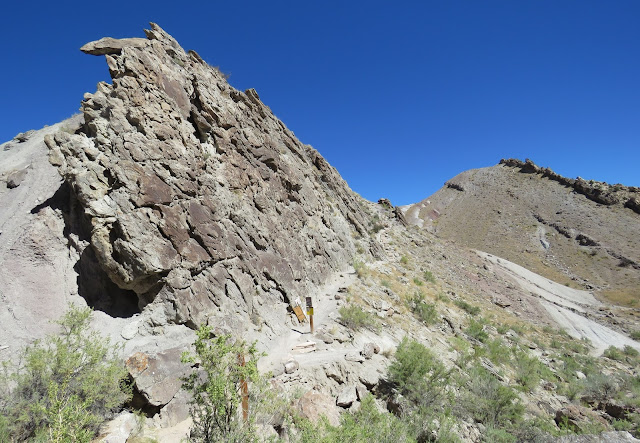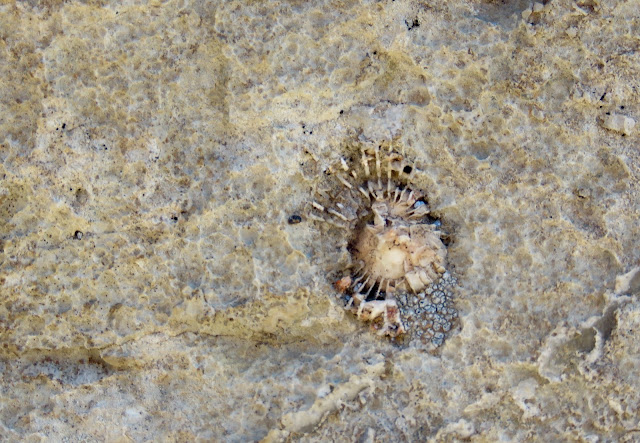Dinosaur National Monument straddles the border of Utah and Colorado with two separate entrances and Visitor Centers. I visited the Fossil Bone Quarry area on the Utah side, and will save the Canyon area in Colorado for another visit.
The road follows the Green River, and I stopped at the first overlook for a picture of the river.
I saw a small herd of deer drinking on the other side of the river from the overlook. (At first I thought they were elk because some had large antlers.)
I took several pictures of the deer and was about to pull out of the overlook, when...
They all started swimming across the river!
So I had to stay and watch that. The last one in line is the smallest.
They emerged on a sand bar below the overlook.
And started browsing in the grass and bushes on the bank.
From this overlook you can see the Green River Campground where I stayed.
And just across the river is one of the oldest ranches in the area, established in the 1880s. It was purchased in 1941 by Douglass Chew and is still operated by his descendants.
Douglass Chew grew up on a nearby ranch owned by his parents seen in this photo at the Visitor Center.
Quarry Visitor Center. From here you take a shuttle to the Quarry Exhibit Hall.
The Quarry Exhibit Hall is a building built over and around a huge "wall of bones," with over 1,500 dinosaur fossils embedded in the stone.
The bones in this display are said to be the most complete skeleton of a young Stegosaurus ever found, which was probably only a few years old when it died. Scientists speculate that the lack of back plates or spikes may be because the young dinosaur hadn't grown any yet...or they just didn't find them. No one knows for sure.
One section of the "wall of bones." These fossils are estimated to be 149 million years old.
Many of the dinosaur fossils found in this area were from Allosaurus.
Allosaurus skull found here.
This is a cast of an entire Allosaurus skeleton that was found in another part of Utah.
Apatosaurus, a large, long-necked, plant-eating dinosaur.
This display has a spike and back plate from a Stegosaurus.
View showing how the building was built around the fossil wall.
You are invited to touch some of the large bones near the floor level.
A new species of dinosaur has recently been excavated in the park. The fossils are currently being studied at a university.
The most complete skeleton found here.
Skull and vertebrae embedded in the wall.
From the Quarry Exhibit Hall there is a hiking trail you can take back to the Visitor Center.
It is called the Fossil Discovery Trail as you can see fossils along the trail.
Beginning of the Fossil Discovery Trail.
In this direction there are supposed to be fossil clams. This is called the Stump Formation.
This may be some...but they were not obvious.
This is what they are supposed to look like.
I spent some time doing careful examination of the rocks, but the above is all I found that was close to looking like clams.
The Morrison Formation contains some dinosaur fossils.
Along this wall there are supposed to be several small dinosaur bones and three larger ones.
Ha!
These large vertebrae are the only ones I saw, and that's because an arrow pointed to it. I guess I wouldn't have made a good paleontologist.
Continuing on to the Mowry Formation...
Where there are supposed to be fish scale fossils.
I never did find any of those.
I did pass some petroglyphs near the end of the trail.
The River Trail is the only trail that dogs are allowed on, so of course, Thistle and I hiked it. It was shady in the late afternoon.
The trail follows the river from our campground to Split Mountain campground.
Wild turkeys on the other side of the river in the evening.
Setting out in the morning to hike the whole trail.
The trail goes up and around that formation on the left.
Approaching Split Mountain.
The trail was high above the river all the way, not right beside it.
Interesting algae/lichen patterns on the rocks.
Reflections in the river.
Looking back.
You can see Split Mountain in the distance, and Split Mt. Campground below by the river.
Ancient ripples turned to stone.
Steps down to the campground.
More ripples...
I found remains of two deer that had been killed by a predator here. I know it was deer because the other one was more recent, with skin and hair still on the leg bone. I wondered what the predator was...coyote? Mountain Lion?
Some color.
This campground appears to be closed...for some time.
Split Mountain
More colorful rock.
Interesting red line going down this rock.
Old swallow nests on the cliffs.
Deer leg...
A Flicker was watching me.
One more look at Split Mountain.
Shhh! Thistle doesn't see it.
This looks like a fossilized leaf print..maybe sycamore.
Starting back.
Another critter.
Curious objects embedded in this rock.
Maybe fossil sea creature?
It was a nice hike, and good place to give Thistle a long walk. No one else was on the trail.
Then I left Thistle home so I could see another part of the park.
Where dinosaurs roamed...
These are views from Cub Creek Road which leads to some Petroglyphs and the Josie Morris Cabin and ranch.
The pavement ends... Josie lived way out there.
Fremont people carved petroglyphs into the "desert varnish" of cliffs.
These petroglyphs are about 1,000 years old.
I can see a bighorn sheep here.
There is a short trail to more petroglyphs here.
Man with a spear?
The most prominent one is a six-foot lizard.
Farther up the road I saw more petroglyphs that were not marked with a sign.
This is the Josie Morris cabin. She grew up with homesteader parents about 40 miles away. As an adult, she decided in 1913 to homestead here along Cub Creek.
She built her own cabin and lived here for 50 years.
The brochure says this may have been the kitchen area.
Living area with central fireplace.
Paper once covered the inside walls.
This was a bedroom with a door that led to the outhouse. In all those years, there was neither plumbing nor electricity, and very few neighbors.
During prohibition in the 1920s and 30s, Josie brewed apricot brandy and chokecherry wine. Her days were filled with chopping wood, milking cows, tending her stock, and garden.
She planted trees around the cabin for shade and fruit. There was also a vegetable garden in this area.
She raised cattle on her ranch. She also had chickens and pigs.
There are two trails into canyons where Josie penned her livestock. I hiked the trail to Box Canyon.
The wooden fences that Josie built to contain the livestock in the canyon still stand.
Only the entrance to the canyon needed fencing. The canyon walls served as its own fence.
The canyon narrowed at the back.
There were several rock caves/shelters on the canyon walls.
I imagined a mountain lion lurking up there waiting for an unsuspecting calf to walk near. I wonder if that ever happened.
Josie was an independent and progressive woman for her times. She wore overalls instead of dresses. She married 5 times and divorced 4 times in a time when divorce was very rare. (I don't know what happened to the 5th husband...maybe he died.) I think those marriages were before she started homesteading here.
In December of 1963, the legendary Josie suffered a broken hip while at her cabin; she died of complications on June 1, 1964.
Turtle Rock
Back at the campground, we had rain that night. Imagine that!
What I saw was only a small part of Dinosaur NM in Utah. There is another whole section in Colorado. A reason for another visit someday.













































































































